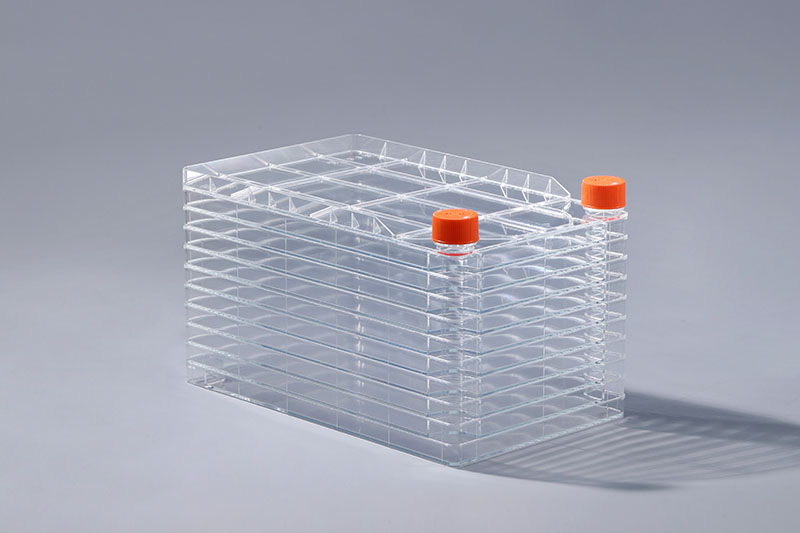مع التطور المتعمق في مجال علوم الحياة ، تُستخدم تقنية زراعة الخلايا على نطاق واسع في العديد من المجالات مثل المستحضرات الصيدلانية الحيوية وإنتاج اللقاح الصناعي والأجسام المضادة وحيدة النسيلة. وفقًا للطرق المختلفة لنمو الخلايا ، يتم تقسيمها إلى فئتين: الخلايا الملتصقة والخلايا المعلقة. إذن ما هي الخلايا التي يمكن استزراعها باستخدام مصانع الخلايا ؟
مصنع الخلايا عبارة عن هيكل متعدد الطبقات من المواد الاستهلاكية لزراعة الخلايا. تشمل المواصفات الشائعة طبقة واحدة ، طبقتين ، 5 طبقات ، 10 طبقات ، 40 طبقة ، إلخ. وهي تستخدم بشكل أساسي في زراعة الخلايا الملتصقة. يجب أن يكون لنمو الخلايا الملتصقة سطح دعم يمكن ربطه ، ويمكن للخلايا أن تنمو وتتكاثر على هذا السطح من خلال الاعتماد على عوامل الارتباط التي تفرزها نفسها أو التي يتم توفيرها في وسط الاستنبات. بعد أن تلتصق الخلايا ، فإنها عادة ما تغطي سطح المستنبت في غضون أيام قليلة وتشكل طبقة أحادية كثيفة من الخلايا ، مثل خلايا Vero ، وخلايا HEK 293 ، وخلايا CAR-T ، و MRC5 ، وخلايا CEF ، والضامة السنخية الخنازير ، وخلايا المايلوما ، و DF - تم إلصاق جميع الخلايا 1 ، والخلايا ST ، وخلايا PK15 ، وخلايا Marc145 ، وما إلى ذلك ، بمصنع الخلية للزراعة. تشير الخلايا المعلقة إلى الخلايا التي تنمو بشكل مستقل عن سطح الدعامة وتنمو في التعليق في وسط المزرعة ، مثل الخلايا الليمفاوية.
تنتج مصانع الخلايا عمومًا من مواد خام البوليسترين ، والسطح كاره للماء. إذا تم استخدامه لزراعة الخلايا الملتصقة ، فيجب معالجة السطح باستخدام TC لزيادة قابليته للماء ، وهو مناسب لنمو الخلايا الملتصقة.
Cell factories are generally produced from polystyrene raw materials, and the surface is hydrophobic. If it is used for adherent cell culture, the surface needs to be treated with TC to increase its hydrophilicity, which is suitable for cell adherent growth.
The FAI climbed 5.9 percent year-on-year in the first 11 months of 2018, quickening from the 5.7-percent growth in Jan-Oct, the National Bureau of Statistics (NBS) said Friday in an online statement.
The key indicator of investment, dubbed a major growth driver, hit the bottom in August and has since started to rebound steadily.
In the face of emerging economic challenges home and abroad, China has stepped up efforts to stabilize investment, in particular rolling out measures to motivate private investors and channel funds into infrastructure.
Friday's data showed private investment, accounting for more than 60 percent of the total FAI, expanded by a brisk 8.7 percent.
NBS spokesperson Mao Shengyong said funds into weak economic links registered rapid increases as investment in environmental protection and agriculture jumped 42 percent and 12.5 percent respectively, much faster than the average.
In breakdown, investment in high-tech and equipment manufacturing remained vigorous with 16.1-percent and 11.6-percent increases respectively in the first 11 months. Infrastructure investment gained 3.7 percent, staying flat. Investment in property development rose 9.7 percent, also unchanged.
 English
English



















































